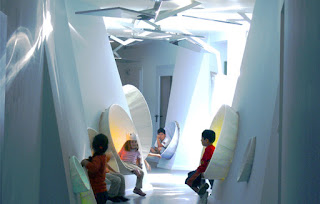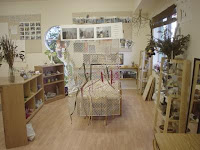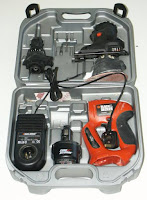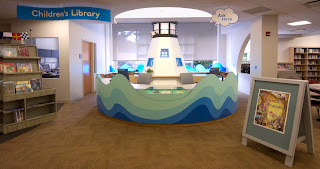Last week I spent 1-1/2 days as an advisor at a partner and advisor meeting for Math Core at the Science Museum of Minnesota (SMM). A collaborative project funded by the National Science Foundation, Math Core for Museums is intended to provide rich, engaging, long-term experiences and environments for children and youth 6 through 12 years old and their parents. Approaching the end of its second year, the 4 partners, SMM, Museum of Science (Boston, MA), ¡Explora! (Albuquerque, NM), and Museum of Life + Science (Durham, NC) have developed working prototypes about ratio and proportion to stimulate mathematical imaginations and builds mathematical abilities and:
• encourage children to acquire deep understanding of math concepts;
• make the practice of math skills surprisingly enjoyable; and
• help children identify success with math as personally relevant and rewarding.]
A long-term exhibition will open at each partner museum bringing several innovations:
• open-ended and planned discovery experiences that engage children and their caregivers with ratio and proportion repeatedly over many museum visits;
• exhibition design approaches that involve visitors in verbalizing their mathematical reasoning, going beyond simple empirical observations to reach more general conclusions; and
• the use of kinesthetic experience and design arts as a major area of application and insight into the nature and use of ratio, proportion and similarity.
Advisors Wanted
As we think of them in museums, advisors bring expertise, experiences, and perspectives that are otherwise difficult to access. Even if a museum had all the expertise it needed in-house, being self-contained would not produce the same healthy vibrancy that engaging colleagues as advisors does. With backgrounds in other museums, in non-museum settings, and in the community, advisors contribute a fresh dose of the outside world. Advisors may have specialties that complement or extend available internal specialties. Often their participation serves as a valuable capacity building opportunity for staff. Whether bringing a critical perspective to long-term museum strategy, providing more extensive experience on a project than is currently available in the museum, or contributing an expertise such as science or literacy, advisors are important among a museum’s stakeholder groups as I’ve written about before.
Over the years I have had the good fortune to be a well-used advisor on several projects. Looking towards the other end of the advisor spectrum, I have also been invited to be an advisor and provide a letter of support; perhaps I heard when the project was funded but then heard not a word about the project. When I have been a well-used advisor, I have been put to work productively on a project’s behalf. This last week’s project was definitely such an invigorating and rewarding opportunity. Over the course of two terrific days, I thought about what was coming together to produce a highly successful meeting that significantly advanced the project and justified the considerable expense involved. While this is a large project that is well-funded, the underlying thinking that applied here can also work for smaller projects and in smaller museums.
My observations and perspective are as an advisor and are also informed by comments from other advisors and partners. They cluster in a few areas.
Making the Most of Advisors
Three consideration make the most of advisors and partners coming together in one place over a period of time to be highly productive.
• Relevant and deep expertise about a topic or topics. A wide range of expertise is required for any complex project. I certainly think collaboratively creating an interactive exhibition about mathematics for children and youth (at 4 locations) qualifies as complex. As people introduced themselves and shared observations, it was clear that the assembled expertise reflected the full dimension of the project, fuller than I had first realized. It was varied, deep, and relevant. Various types of expertise were present, for instance: in accessibility, mathematics, embodied cognition, new media, visitor research, math education, and prototyping. In some cases, the expertise of a partner or advisor was quite specialized and just what the project needed in a particular area.
• A mix of perspectives. Perspectives, while informed by expertise are also shaped by experience and background bringing different lenses and filters to a topic or project. Perspectives criss-cross and intersect in interesting ways to open up a question, tackle an issue, or find a solution. Some similar but distinct viewpoints were apparent among internal and external and museum researchers as well as mathematics researchers; mathematics and science educators; educators from formal and informal learning settings; museum and non-museum informal settings. Viewpoints on how messy exhibit activities could be varied among partner institutions .
| Gathering input on moving ahead |
A Productive Gathering
An unimaginable amount of thought, planning and pre-planning goes into any meeting, let alone a meeting that brings dozens of people together from a dozen states, is highly accountable to the outcomes of a significant project, and is respectful of people’s time. I thought several of the features of the meeting really contributed to its value.
Great gatherings start with thoughtful advisor and partner selection. Besides selecting for expertise and perspective, advisors have to be interested in the project and value the opportunity to contribute. This means a willingness to make time on their calendar, to participate actively and turn-off phones, and to believe fully that what others have to contribute is as, or more interesting, than what they have to say. After you have the group of partners and advisors you want, the following come into play.
• Advanced preparation. People are busy. Get dates on the calendar early with clear information start and end times and travel arrangements; give a progress report on the project; set and share meeting goals. Send the agenda and any reports.
• Project goals and commitments at the forefront. Nothing serves keeping on track as well as re-visiting project goals at each step of the process. While goals are bound to morph somewhat, they are the best accountability tool and centering device I know of. When a meeting brings together people who have not been working everyday on this project, opening with goals brings everyone together and focuses their expertise on the same set of important ideas. There were several points in the meeting where returning to the goals moved us forward.
• Create an environment in which everyone can participate. Somewhere between extending a friendly invitation and setting a firm expectation, make it clear that the full range of experiences, perspectives, and expertise are welcome, valued, and needed. This practice is established early in a project’s history. At the first partner and advisor meeting, advisors were all asked to make a presentation about a similar project they’d been involved in and its lessons for Math Core.
| How does this work? A question for learners and prototypers |
• Ample time for sharing. This meeting was well-paced with time for the whole group together, sharing results of a research study, a preliminary evaluation report and the preliminary accessibility report, along with large group discussions and reflections. There was also time and place for side conversations which was built into a “non-conference” exercise that built on side-bar conversations.
Playing it Forward
I think the meeting met its goals (and then some). Partners and advisors left feeling they had accomplished a lot and were eager to get going on the next steps. For me, great, interesting ideas and insights from partners and advisors boiled up from a quick 22 hours that I will be noodling on, working with, and writing about probably for years to come. Five seem particularly engaging.
• The value of learning, or of an experience, is how meaningfully it comes to live in a future behavior or experience. Thanks to Paul Tatter, ¡Explora!
• Children aren’t afraid of problem solving but we have to give them the materials and problems to solve to make it easy for them to see the underlying math (or other concepts) involved. Thanks to Dr. Hyman Bass, University of Michigan.
• Gestures–pointing, moving arms, making shapes in the air–as evidence of what kind of an experience a person is having. Thanks to Ricardo Nemirovsky and Molly Kelton from San Diego State University.
• Parents take their role as their child’s teachers very seriously. Their only role model, however, is the classroom teacher. How can we model, or coach, parents in informal teaching?
• Create experiences for learners to make it easy for them to move from messing around, to fluency, to improvisation.
My Thanks
| Partners and planners |





